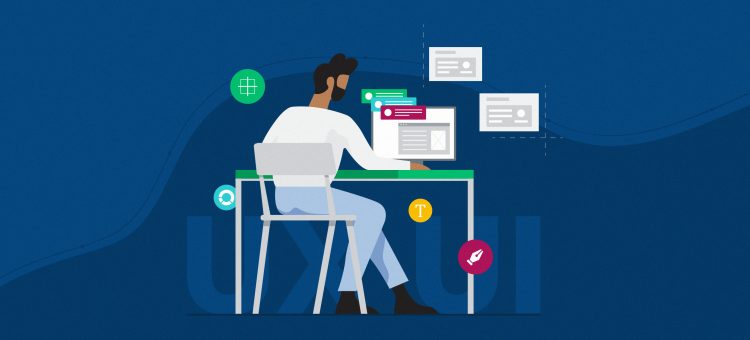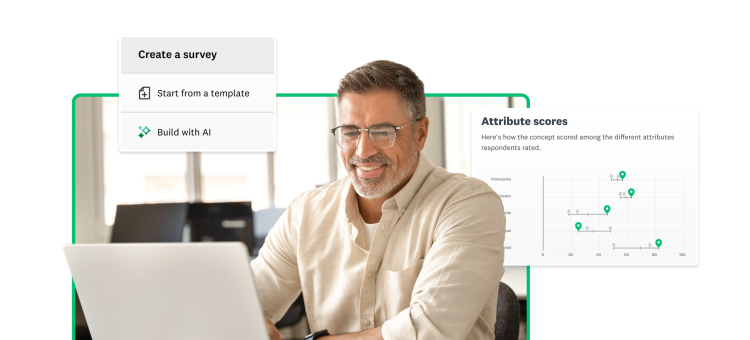SurveyMonkey’s mission is to power the curious. Our products enable individuals, teams, and organizations to turn feedback into action. How does curiosity apply to product design? Great designers ask a lot of questions. Who are we designing for? Why? What do our users want and need? How can we innovate?
The answers gathered from these questions help product designers improve the user experience. We asked our team for their insights on what it’s like to work at SurveyMonkey and how to succeed as a product designer.
What does our Product Design team look like?
SurveyMonkey’s Product Design team is composed of over twenty designers from all around the world. We have a design presence in our offices in San Mateo, Portland, Ottawa, Dublin and Amsterdam.
This global team is responsible for the discovery and definition of customer needs, the ideation and conception of potential product solutions, and the detailed design of the experience that will enable both our customer and business to succeed.
We have a nice variety of talent across the world. There is an eagerness to learn and cooperate with Product and Engineering.
Ercan Celik, Senior Director of Product Design at SurveyMonkey
Design principles as a guiding light
Product Design at SurveyMonkey is a centralized team, but they are embedded in cross-functional teams across the organization and the globe! They work together to create a strong design culture and community of practice.
One example of this is creating the team’s design principles. The design principles were developed as a joint effort between our Product Designers and the cross-functional partners they work with. These are the rudders that guide decision-making as they work closely together and with other departments and our customers to build amazing customer experiences.
While their main goal is to guide the work, the design principles are a useful framework to describe the ethos of the Product Design team.
Falling in love with the problem
Complex problems are challenges that our Product Design team faces on a daily basis. With so many directions you can go when solving a problem with design, it is critical to truly fall in love with the problem itself before you begin.
What is the problem you’re trying to solve? How do the various elements of design tie back to the problem you’re seeing? SurveyMonkey Product Designers don't start designing until they understand the problem and see it as an opportunity to make an impact.
There is a good degree of autonomy and space given to fall in love with problems before we have to start solutioning.
Greg Johnson, VP Engineering at SurveyMonkey
As you might have guessed, SurveyMonkey designers use our own platform to support their work. With our products, they can conduct user research, validate assumptions, and gather feedback on their designs after launch.
Listening closely to our customers, partners, and peers cultivates empathy and gives our team confidence that they’re building things that solve real problems for customers. Our designers iterate based on input from others—and use fresh perspectives to turn good designs into great designs with purpose.
Problems are the most interesting part of our job. It keeps us up at night, but it's so satisfying to solve and see good results.
Gal, Senior Product Designer at SurveyMonkey
Embrace constraints, but push past possible
Constraints exist anywhere you go: home, work, school, outer space. For our Product Designers those constraints show themselves in the form of customer needs, business needs, and various technical constraints.
Our Designers are experts at balancing the constraints. Most importantly, they’re a counterweight to the status quo. One of SurveyMonkey’s core values is Innovate for Customers. We grow and innovate right alongside our customers to deliver value while listening, understanding, acting, and keeping at it.
If you’re going to innovate, you’ll inevitably need to challenge the status quo. Our designers are customer champions that sit at the unique intersection of product, business strategy, and engineering—and they use their seat at the table to offer creative visions of the future to inspire teams to think beyond today’s limitations.
Make it simple
There is nothing more frustrating than setting up a new product only to find it is too complicated to use. Simplicity is a key design principle. If you want your designs to be adopted and engaged with by your users, you need to make sure they are easy to use and understand. The simpler the product, the more likely it is to be useful and used.
SurveyMonkey Designers make it easy for customers to do complex work. They spend time reducing clutter and breaking down workflows so our customers don't have to—empowering them to make quick progress and achieve the best possible outcome.
What I always strive for is to help users achieve their goals in the simplest and most efficient way possible.
Michel van der Hoek, Senior Product Designer, SurveyMonkey
Meet customers where they are
Designing for our customers begins with curiosity and discovery. Our Product Design team makes it their priority to know customers well enough to design with their wants and needs in mind. Thousands of people around the world use SurveyMonkey products. It’s the job of our Product Designers to think about everyone as they design.
When your customer base is as diverse as SurveyMonkey’s is, how do you ensure your customers feel heard? You must design with them in mind. You might think you know what your customers need and want, but if you really want to know you must engage in active listening.
Consider all the ways in which your designs will impact the customers. Are you following globalization best practices? How are we designing for accessibility? Empowering and respecting your customers start with a design that meets them where they are.
We tend to be highly collaborative, growth-oriented, and very open and friendly. People are really eager to collaborate and learn.
Erica Tjader, VP of Product Design at SurveyMonkey
What makes Product Design at SurveyMonkey unique?
We asked the team what they enjoyed most about working on the Product Design team, and their answers came across in three clear themes: helping our customers, the challenging work, and their teammates.
Our Product Designers find fulfillment when they are able to talk with our customers and hear how what they’ve built has improved the customers’ day to day work. For Product Designers, being the user’s advocate is both an advantage and a challenge. They are able to build a phenomenal experience for our users, yet balance that experience with a realistic and deliverable product.
The work at SurveyMonkey is challenging. Our Product Designers need to balance shipping a complex product, all while juggling constraints and cross-functional relationships. The Product Design team finds the push and pull between these factors both challenging and fascinating, and they contribute to our Designers’ professional growth and development.
The Product Design team at SurveyMonkey is talented and growth-oriented. Everyone on the team has their own design superpower and helps each other to learn and grow. The culture is one of openness, honesty, and trust. This trust is foundational to the team and exists among individual contributors as well as design leadership. They work hard, play hard, and stay curious.
Still Curious?
Curiosity fuels everything we do. It’s what inspired our Product Design team to start a blog. Check it out at Curiosity by Design on Medium. It’s not only a great example of how we champion a curious, growth-mindset at SurveyMonkey, but it’s a great way to keep up with our team, the design process, and their experience building our products!



